This photo was taken about an hour after sunrise on November 5 after a cold front moved in and pushed the overnight temperature down to a chilly 57° F (14° C):

When I go afield I am not looking for the rare and unusual birds, although they are welcomed when they appear. Over almost ten years of birding this local patch, I have identified 142 species no more than a mile from my home within the confines of the West Miramar Water Conservation Area, photographing nearly all of them.
Only a few were new to my life list (such as Black-whiskered Vireo, Short-tailed Hawk and Bell's Vireo) and two or three are considered "non-countable" by the American Birding Association (feral Muscovy Duck, captive-reared freely-released Whooping Crane and Greater Flamingo-- the latter I maintain represented a wild flock driven by hurricane winds from their usual haunts 100 miles to the south in Everglades National Park). Yet, because I did not get my first DSLR camera until a few years ago, many provided my first photo opportunities-- events that enliven the spirit of discovery.
The waning full moon had not yet set. Mary Lou was already out in head of me.

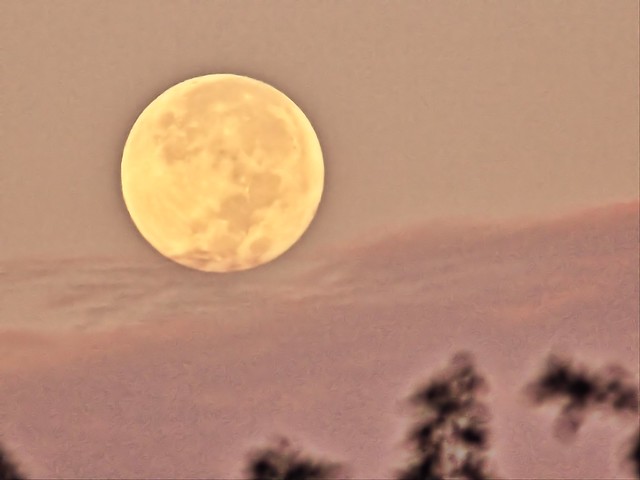
We got out just before sunrise the first morning. As we entered the gravel path, the sun was just high enough to catch the undersides of a Wood Stork as it flew over us.

The morning glow added beauty and defintion to the white plumage of this Great Egret as it responded to my presence by moving away a bit:

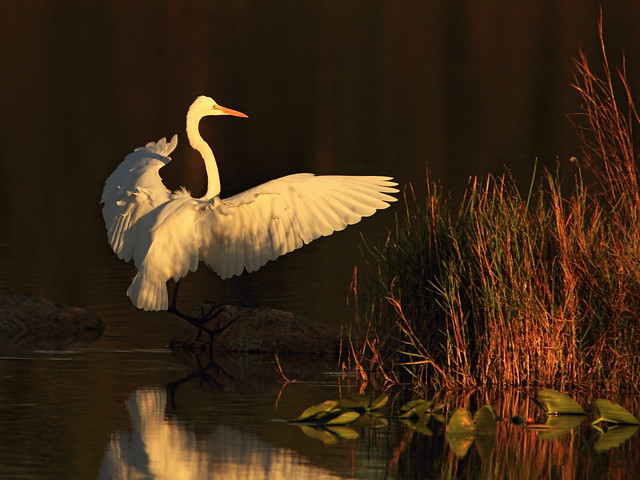
Nearby, an Anhinga protested as I drew near:

At dawn the sunlight cast long shadows on the ground but fully illuminated the clouds above the lake:
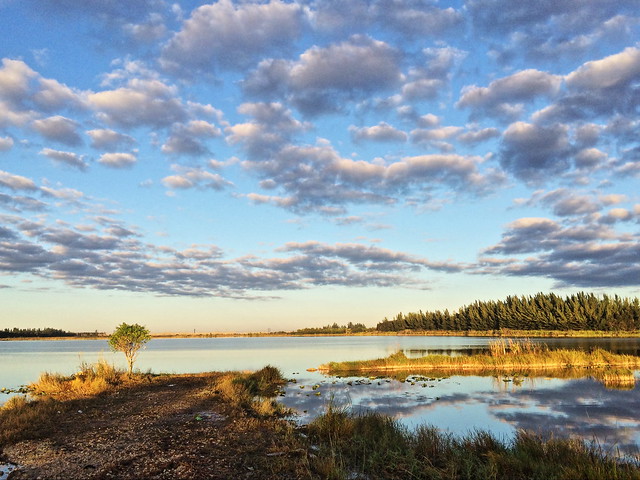
All was not beauty and splendor. Water levels decreased somewhat after the end of the wet season in mid-October, so the off-road ("wreckreational") vehicles had free access to the "protected" wet meadows. This is their playground where they can spin their wheels and cover each other in mud:

Unknowingly benefiting from their intrusion, wading birds were afforded new waterways in the ruts and potholes created by the ORVs. A pair of White Ibises probed the mud puddles:

It was a joy to hear the familiar sound of an Osprey calling overhead:
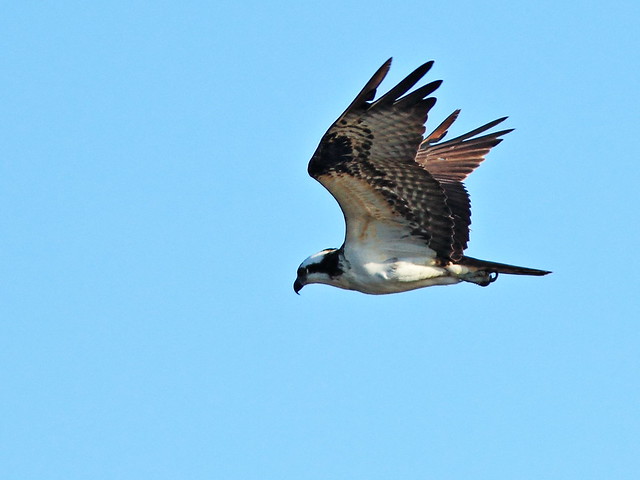
A Little Blue Heron and a Great Egret moved towards a disturbance in the water.

The Little Blue flew offshore to an exposed rock:

I checked out the shrubby area on higher ground next to the levee. Gray Catbirds had already migrated out of Illinois before we left. Here they were the most common land birds. Despite their numbers and constant mewing calls, catbirds are shy and do not sit still for a photo. When one lands out in the open it is almost guaranteed to disappear into the foliage within seconds.
The catbirds outnumbered the abundant Northern Mockingbirds such as this one:
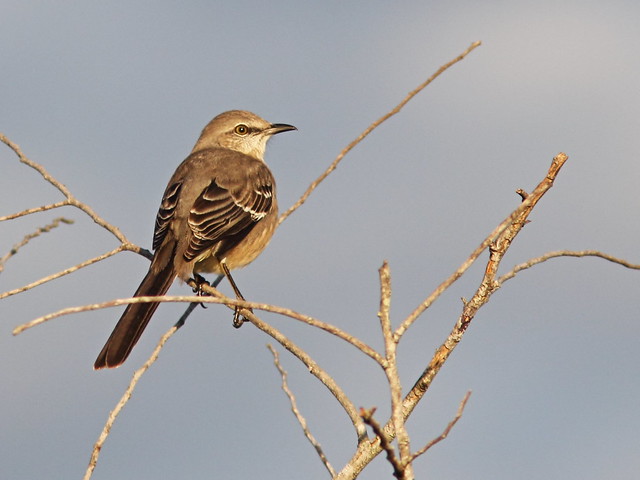
This catbird ducked away, but not before I caught sight of its conspicuous rufous under-tail coverts:


Another member of the Mimic Thrush (Mimidae) family that includes mockingbirds and catbirds put in a brief appearance-- a Brown Thrasher:

All in all, I recorded 45 bird species during the first three mornings out in the local wetlands, but non-avian wildlife, such as this Monarch butterfly did not escape notice:

Long-tailed Skipper:
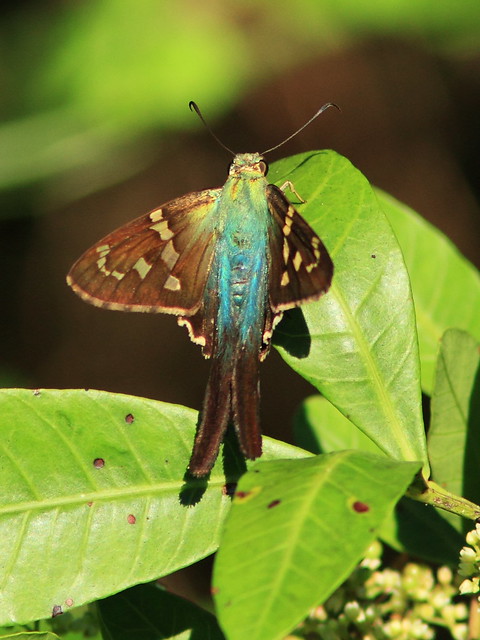
awesome shots! that opening one is truly spectacular! and loved the light in the first couple of egret shots! haven't seen a brown thrasher since i left wisconsin. we get plenty of mockers here, but i've never seen a catbird in person.
ReplyDeleteWonderful photos as usual. I love the morning light on the egret.
ReplyDeleteGorgeous views and so beautiful pictures !
ReplyDeleteGreetings
Oh my goodness...where do I begin? What glorious images and scenes. That first photo at the beginning just awed me to almost becoming speechless. Wow!!!!!
ReplyDeleteYour birds of course are always superior in image and kind. Now....I wanna move and become your neighbor with this in my 'back yard'. They're all very good, but I'm drawn to the Little Blue on the rock...such a fantastic reflection.
Thanks for sharing the link with us bird enthusiasts this weekend! Much appreciated.
Fantastic shots that take my breath away!
ReplyDeleteThanks for your comment about pumpkin seeds! The way to find out about possible anti-inflammatory properties of the acorn seeds you threw out, is to give them to someone who has arthritis or look it up on google...
ReplyDeleteBeautiful pics! Love the moon! I want to learn how to take pics of it, now we live in the mountains, and I see the moon regularly. Are these pics HDR?
Don't know if my comment got through...Lovely pics! Love the moon:) Are these taken with HDR? Maybe look up the properties of the acorn squash you threw out on google?
ReplyDeleteWow ! Fantastic array of nature photography!
ReplyDeleteHappy Day to you,
artmusedog and carol (A Creative Harbor)
Wow - what amazing and beautiful photos!
ReplyDelete@Jeannette--
ReplyDeleteHi Jeannette,
I use Canon Digital Professional Processor (DPP) which includes an HDR emulation. This is what I used in this blog post.
When I wish to create an HDR image from an original RAW FILE I make three identical crops, leaving the original as it is out of the camera, then underexposing one and overexposing the other (i.e., increasing or decreasing brightness by an equal number of stops). I then layer the three exposures in DPP and select one of the pre-sets and tweak the chosen one. Purists do not call this true HDR because only a single original is involved.
I think HDR effects work best in landscapes and also large birds and mammals. It accentuates feather and fur detail but also can look artificial or "cartoon-ish."
I also use one-step noise reduction in Corel PaintShop Pro if the image is too grainy.
Thanks!
Ken
What a pleasure to view your bird photos. I must say the Wood Stork always catches my eye because they are so different looking. Also that sunrise was so glorious. A very nice post.
ReplyDeleteHI Kenneth All your shots are so go that I really do not know where to start to comment. Well the first shot is amazingly beautiful. I love the shots of the Little Blue Heron with its reflection. Great shot of the Mockingbird and the Monarch is like stain glass. I also like the Long tailed Skipper.
ReplyDeleteStunning photos and fascinating birds.
ReplyDeleteWow! What an amazing collection of birds. Love that Stork and the Osprey.
ReplyDeleteAnother fabulous selection Ken from your local patch. I'm with you on the leisurely approach ... no point in rushing when there is so much on offer.
ReplyDeleteWhat an adventure! Fantastic shots!
ReplyDeleteSuch wonderful beauty in each of the image shares~
ReplyDelete